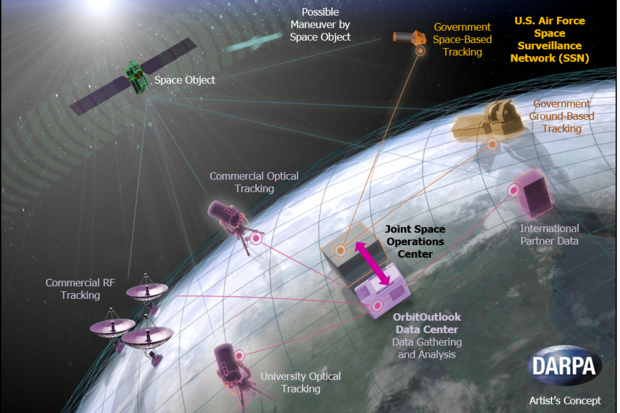The drone crashed in Mogadishu’s Waabari district this week where it was found and pictured on social media.



You got to luv this one.
The security agency must defend itself in a US appeals court for violating the rights of a convicted bomber by supposedly illegally spying on him.
A US appeals court will weigh a constitutional challenge on Wednesday to a warrantless government surveillance program, brought by an Oregon man found guilty of attempting to detonate a bomb in 2010 during a Christmas tree-lighting ceremony.
The case before a three-judge panel of the 9th US Circuit Court of Appeals is the first of its kind to consider whether a criminal defendant’s constitutional privacy rights are violated under a National Security Agency (NSA) program that allows spying on Americans’ international phone calls and internet communications.

Now, here is a longer term concept. Could we see a day soon where we have some model of an EPA in Space due to the already junk material (namely abandoned/ broken satellites, etc.) and mining? Wonder who will get the contracts for space cleanup?
DARPA recently said that it had finished integrating seven space-watching networks that will feed tons of new Earth-orbiting junk data into what the agency calls “the largest and most diverse network of space situational awareness networks ever assembled.”
+More on Network World: NASA’s hot Juno Jupiter mission +
DARPA’s OrbitOutlook (O2) program brings seven previously separate new space sensor networks together that could ultimately feed into the United States Space Surveillance Network (SSN), a worldwide network of 29 military radar and optical telescopes operated by the Air Force as well as NASA, the FAA and other entities that could use the information.

The Defense Advanced Research Projects Agency has finished its work to integrate live data feeds from several sources into the U.S. Space Surveillance Network run by the Air Force in an effort to help space monitoring teams check when satellites are at risk.
SSN is a global network of 29 military radar and optical telescopes and DARPA added seven space data providers to the network to help monitor the space environment under its OrbitOutlook program, the agency said Wednesday.
DARPA plans to test the automated algorithms developed to determine relevant data from the integrated feed in order to help SSA experts carry out their mission.
Looks to be quite fascinating…
But is anyone else annoyed by the never ending use of the word “cyber”?
*sigh*.
Tapping into the geopolitics of hacking and surveillance, Ben Makuch travels the world to meet with hackers, government officials, and dissidents to investigate the ecosystem of cyberwarfare.
CYBERWAR premieres Tuesday, July 5th, at 10:30 P EST on VICELAND.

Having UAVs conduct routine aerial surveillance is already having a transformative effect on farming and and energy production but they can only operate when there’s a human at the controls. That’s about to change thanks to an autonomous drone system that not only flies but also maintains itself. Tel Aviv-based UAV Airobotics has debuted a completely automated patrol drone system of the same name that is capable of operating with virtually no human intervention.
The system is composed of three parts: the drone itself, the “Airbase” robotic base station and the command software. It uses an “Optimus” UAV that can carry a 1-kilogram payload for up to 30 minutes. When the UAV finishes its patrol, it will land atop the base station whereupon a robotic arm will automatically swap out its battery and payload. All of this is controlled by the integrated software which enables users to pre-program flight paths as well as view real-time video and data feeds. The Airobotic system will likely find use in the mining and oil and gas industries as an aerial mapping platform, though it could easily be applied to any repetitive delivery or flyover task.
Think your personal time is yours? Think again.
A new initiative from the U.S. Office of the Director of National Intelligence aims to create an intelligent surveillance system that can analyze live video and spot suspicious behavior in real time. According to Defense One, the research project is called Deep Intermodal Video Analytics (a.k.a. DIVA) and it will be a joint effort between academics, the private sector and ODNI’s Intelligence Advanced Research Projects Agency.
In an announcement, IARPA officials laid out the project’s goals: “The DIVA program will produce a common framework and software prototype for activity detection, person/object detection and recognition across a multicamera network,” IARPA officials wrote. “The impact will be the development of tools for forensic analysis, as well as real-time alerting for user-defined threat scenarios.” In other words: the system should be able to identify suspicious behavior in real-time.
One of the problems with existing systems is that they can identify individual people or objects, but not many of them at the same time, or the complex interactions between them. The DIVA system as it is proposed would be able to identify certain types of movements like a person carrying a firearm, two people exchanging an object, or someone walking up and abandoning a potentially dangerous object on the street.

WASHINGTON, 9 June 2016. U.S. intelligence experts are asking industry for ideas on developing networks of unmanned underwater vehicles (UUV) for covert surveillance of international ship traffic in important harbors, waterways, and choke points.
Officials of the U.S. Intelligence Advanced Projects Agency (IARPA) in Washington issued a sources-sought notice Tuesday (IARPA-BAA-16–09) for the UnderWatch project.
The IARPA UnderWatch project seeks to use UUV networks to monitor ships and maneuver to inspect contacts of interest. IARPA is the research arm of the U.S. Director of National Intelligence.


I love contract season with the US Government because you get to see all of the cool projects being awarded.
CAMBRIDGE, MA — The U.S. military’s unmanned underwater vehicles (UUVs) depend on stealth as they conduct surveillance and reconnaissance and other missions in the deep oceans. With Global Positioning System (GPS) signals unable to penetrate the ocean’s surface, these UUVs can rely on inertial sensors to provide acceptable positioning information during short missions. On longer missions, however, inertial sensors accumulate error, forcing the vehicles to risk exposing themselves to enemies as they periodically surface to obtain a GPS fix.
The Defense Advanced Research Projects Agency (DARPA) is addressing this issue by funding the development of a small number of acoustic transmitters that can be anchored to fixed locations around ocean basins to serve as an undersea navigation constellation, according to a May 10 release by the Cambridge-based nonprofit company Draper.
By measuring its range to multiple signals emanating from known coordinates, an undersea vehicle can operate continuously with accurate navigation information without needing to surface for GPS fixes or to use high cost inertial systems that are typical of current UUVs. DARPA awarded a contract on March 15 to a Draper-led team to begin development of a solution for the Positioning System for Deep Ocean Navigation (POSYDON).